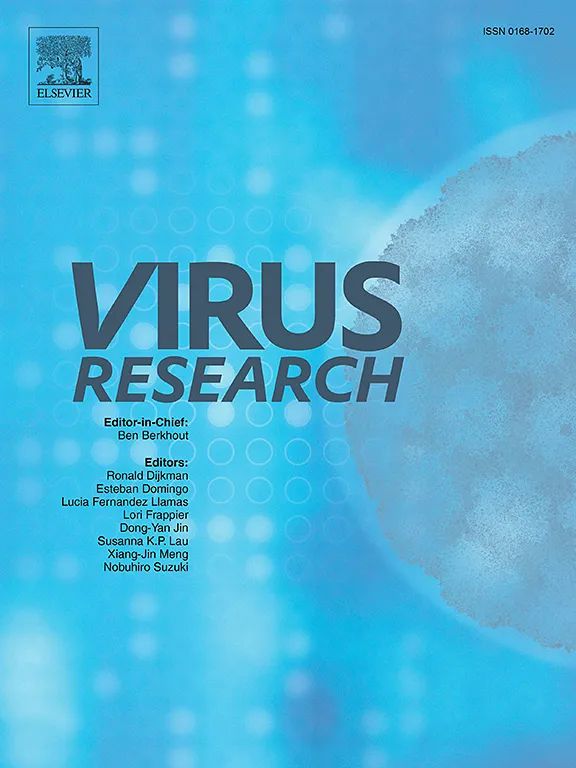Viral coexistence and insertional mutations in the ORF8 region of SARS-CoV-2: A possible mechanism of nucleotide insertion
IF 2.5
4区 医学
Q3 VIROLOGY
引用次数: 0
Abstract
The virus obtained from a swab sample ID: S66 in Hiroshima was reported to have a single T-base insertion in the ORF8 coding region. However, no T insertion was observed when we determined the genomic sequence using another method. We then extracted RNA from the S66 swab sample and sequenced the insertion site using the Sanger method. The resulting waveform was disrupted beyond the insertion site, suggesting the presence of a mixed population of viruses with different sequences. Through plasmid cloning of RT-PCR amplification fragments and virus cloning by limiting dilution, along with TIDE analysis to determine the ratio of components from the Sanger sequencing waveform, it was confirmed that the sample contained a mixture of viruses with varying numbers of T-base insertions. The virus with one T insertion (T1+) was predominant in 70–75 % of the genomes, and genomes with T0, T2+, T3+, T4+, and T5+ were also detected. No T-base insertion mutations were observed in the ORF8 region in three other SARS-CoV-2 samples. In the S66 sample, a C27911T point mutation near the insertion site in the ORF8 region resulted in a sequence of seven or more consecutive T bases, which was the cause of the T-base insertion. When the cloned S66 virus (T1+) was passaged in cultured cells, there was a tendency for viruses with more insertion bases to become dominant with successive generations, suggesting that the T-base insertion was due to polymerase stuttering. The insertion of T bases resulted in synthesis of deletion mutants of the ORF8 protein, but no significant change was observed in the proliferation of the viruses in cultured cells. A search of the GenBank database using NCBI BLAST for viruses similar to S66 with T-base insertion mutations revealed hundreds of viruses widely distributed on the molecular phylogenetic tree. These base insertion viruses were thought to have occasionally arisen during the virus infection process. This study suggests one mechanism of insertion mutations in SARS-CoV-2, and it is important to consider the emergence of future mutant strains.
SARS-CoV-2 ORF8 区的病毒共存和插入突变:核苷酸插入的可能机制。
据报道,从广岛咽拭子样本(ID:S66)中获得的病毒在 ORF8 编码区有一个 T 碱基插入。然而,当我们用另一种方法测定基因组序列时,却没有发现 T 插入。随后,我们从 S66 拭子样本中提取了 RNA,并使用 Sanger 方法对插入位点进行了测序。结果发现,在插入位点之外的波形被打乱,这表明存在不同序列的混合病毒群。通过对 RT-PCR 扩增片段进行质粒克隆和用限制稀释法克隆病毒,以及用 TIDE 分析法确定 Sanger 测序波形中各成分的比例,证实样本中含有不同数量 T 碱基插入的混合病毒。有一个 T 插入(T1+)的病毒在 70-75% 的基因组中占主导地位,此外还检测到有 T0、T2+、T3+、T4+ 和 T5+ 的基因组。在另外三个 SARS-CoV-2 样本中,ORF8 区域未发现 T 碱基插入突变。在 S66 样本中,ORF8 区插入位点附近的 C27911T 点突变导致序列中出现 7 个或更多的连续 T 碱基,这就是 T 碱基插入的原因。当克隆的 S66 病毒(T1+)在培养细胞中传代时,插入碱基越多的病毒在连续几代中越显性,这表明 T 碱基插入是由于聚合酶的滞后造成的。T 碱基的插入导致 ORF8 蛋白的缺失突变体的合成,但在培养细胞中病毒的增殖方面没有观察到明显的变化。利用 NCBI BLAST 在 GenBank 数据库中搜索与 S66 相似的 T 碱基插入突变病毒,发现了数百种广泛分布在分子系统树上的病毒。这些碱基插入病毒被认为是在病毒感染过程中偶尔出现的。这项研究提出了 SARS-CoV-2 插入突变的一种机制,对考虑未来突变株的出现具有重要意义。
本文章由计算机程序翻译,如有差异,请以英文原文为准。
求助全文
约1分钟内获得全文
求助全文
来源期刊

Virus research
医学-病毒学
CiteScore
9.50
自引率
2.00%
发文量
239
审稿时长
43 days
期刊介绍:
Virus Research provides a means of fast publication for original papers on fundamental research in virology. Contributions on new developments concerning virus structure, replication, pathogenesis and evolution are encouraged. These include reports describing virus morphology, the function and antigenic analysis of virus structural components, virus genome structure and expression, analysis on virus replication processes, virus evolution in connection with antiviral interventions, effects of viruses on their host cells, particularly on the immune system, and the pathogenesis of virus infections, including oncogene activation and transduction.
 求助内容:
求助内容: 应助结果提醒方式:
应助结果提醒方式:


